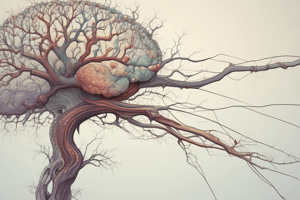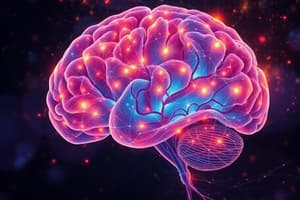Podcast
Questions and Answers
What is the primary purpose of synaptic pruning in the brain?
What is the primary purpose of synaptic pruning in the brain?
- To enhance sensory perception.
- To increase the number of synapses available.
- To replace old synapses with new ones.
- To improve the efficiency of brain connections. (correct)
During which period does the brain create the highest number of synaptic connections?
During which period does the brain create the highest number of synaptic connections?
- Adolescence.
- Young adulthood.
- Late childhood.
- Early childhood. (correct)
How does synaptic plasticity differ between teenagers and adults?
How does synaptic plasticity differ between teenagers and adults?
- Teenagers have fewer synapses than adults.
- Teenagers have less ability to strengthen synapses.
- Teenagers can learn new skills more slowly than adults.
- Teenagers experience faster learning and stronger synapse connections. (correct)
What is the last brain region to mature, and why is this important?
What is the last brain region to mature, and why is this important?
How does substance abuse relate to synaptic plasticity in teenagers?
How does substance abuse relate to synaptic plasticity in teenagers?
What impact does stress have on adolescent brain development?
What impact does stress have on adolescent brain development?
Which statement about synaptic connections during development is accurate?
Which statement about synaptic connections during development is accurate?
What developmental change occurs in the teenage brain regarding planning and decision-making?
What developmental change occurs in the teenage brain regarding planning and decision-making?
What effect does myelination have on brain function as one matures?
What effect does myelination have on brain function as one matures?
Which factor primarily contributes to teenagers being impressionable?
Which factor primarily contributes to teenagers being impressionable?
Match the following terms with their definitions:
Match the following terms with their definitions:
Match the following age-related changes in the brain with their descriptions:
Match the following age-related changes in the brain with their descriptions:
Match the following effects of stress on adolescent brain development:
Match the following effects of stress on adolescent brain development:
Match the following characteristics of the teenage brain with their implications:
Match the following characteristics of the teenage brain with their implications:
Match the brain regions with their roles in development:
Match the brain regions with their roles in development:
Match the following statements about brain development with their truths:
Match the following statements about brain development with their truths:
Match the following developmental phases with their key activities:
Match the following developmental phases with their key activities:
Match the following consequences of adolescent brain characteristics:
Match the following consequences of adolescent brain characteristics:
Match the following statements about brain connections with their implications:
Match the following statements about brain connections with their implications:
Explain how synaptic pruning improves brain efficiency during adolescence.
Explain how synaptic pruning improves brain efficiency during adolescence.
What is meant by synaptic plasticity, and why is it particularly pronounced in teenagers?
What is meant by synaptic plasticity, and why is it particularly pronounced in teenagers?
Discuss the role of myelination in brain development and its timeline.
Discuss the role of myelination in brain development and its timeline.
How do high numbers of synapses in a teenager's brain relate to learning capabilities?
How do high numbers of synapses in a teenager's brain relate to learning capabilities?
What implications does the late maturation of the frontal lobe have for teenagers?
What implications does the late maturation of the frontal lobe have for teenagers?
In what way can addiction in teenagers be viewed as a form of synaptic plasticity?
In what way can addiction in teenagers be viewed as a form of synaptic plasticity?
How does the process of synaptic pruning differ across various parts of the brain?
How does the process of synaptic pruning differ across various parts of the brain?
What risks are associated with stress during adolescence in relation to brain development?
What risks are associated with stress during adolescence in relation to brain development?
Why is it significant that teenagers learn faster than adults?
Why is it significant that teenagers learn faster than adults?
Describe how environmental factors influence synaptic plasticity in teenagers.
Describe how environmental factors influence synaptic plasticity in teenagers.
Flashcards are hidden until you start studying
Study Notes
Brain Development in Childhood and Adolescence
- Early childhood is marked by rapid synapse creation, reaching nearly double the adult count by age one.
- Synaptic pruning occurs as the brain eliminates unused connections, enhancing efficiency.
- More connections do not equate to better functionality; excess pathways can hinder brain efficiency.
- During adolescence, the brain refines its connections in response to learning and experiences.
Synaptic Pruning
- Synaptic pruning strengthens utilized pathways while diminishing those not frequently engaged.
- This biological process leads to improved cognitive abilities, such as decision-making and critical thinking in teenagers.
- Different brain regions undergo pruning at varying stages, influenced by developmental changes in thought and learning.
Teenage Brain Characteristics
- Teen brains are wired for faster learning due to higher synapse counts and synaptic plasticity.
- Synaptic plasticity allows for adaptability in response to environmental stimuli, promoting brain responsiveness.
- Brain maturation continues until the mid to late 20s, with myelination enhancing connections over time.
Frontal Lobe Development
- The frontal lobe is the last brain area to mature, critical for judgment, impulse control, and empathy.
- Immature connections in this area lead to increased risk-taking behaviors in teenagers.
Addictive Behaviors
- Teenagers can experience heightened susceptibility to addiction due to enhanced synaptic plasticity.
- Addiction pathways solidify rapidly, making teenagers more prone to substance abuse than adults.
- Early addiction interferes with healthy brain development and complicates recovery efforts later in life.
Impact of Stress
- Stress during adolescence can have lasting effects, increasing the risk of mental health issues like depression in adulthood.
- Understanding research findings about teenage brain behavior aids parents and educators in comprehending adolescent actions.
Conclusion
- The teenage brain is distinctly adaptable, benefiting and suffering from external influences due to its developmental stage.
- Awareness of brain mechanics can guide better support for adolescents as they navigate complex experiences.
Brain Development in Childhood and Adolescence
- Early childhood is marked by rapid synapse creation, reaching nearly double the adult count by age one.
- Synaptic pruning occurs as the brain eliminates unused connections, enhancing efficiency.
- More connections do not equate to better functionality; excess pathways can hinder brain efficiency.
- During adolescence, the brain refines its connections in response to learning and experiences.
Synaptic Pruning
- Synaptic pruning strengthens utilized pathways while diminishing those not frequently engaged.
- This biological process leads to improved cognitive abilities, such as decision-making and critical thinking in teenagers.
- Different brain regions undergo pruning at varying stages, influenced by developmental changes in thought and learning.
Teenage Brain Characteristics
- Teen brains are wired for faster learning due to higher synapse counts and synaptic plasticity.
- Synaptic plasticity allows for adaptability in response to environmental stimuli, promoting brain responsiveness.
- Brain maturation continues until the mid to late 20s, with myelination enhancing connections over time.
Frontal Lobe Development
- The frontal lobe is the last brain area to mature, critical for judgment, impulse control, and empathy.
- Immature connections in this area lead to increased risk-taking behaviors in teenagers.
Addictive Behaviors
- Teenagers can experience heightened susceptibility to addiction due to enhanced synaptic plasticity.
- Addiction pathways solidify rapidly, making teenagers more prone to substance abuse than adults.
- Early addiction interferes with healthy brain development and complicates recovery efforts later in life.
Impact of Stress
- Stress during adolescence can have lasting effects, increasing the risk of mental health issues like depression in adulthood.
- Understanding research findings about teenage brain behavior aids parents and educators in comprehending adolescent actions.
Conclusion
- The teenage brain is distinctly adaptable, benefiting and suffering from external influences due to its developmental stage.
- Awareness of brain mechanics can guide better support for adolescents as they navigate complex experiences.
Brain Development in Childhood and Adolescence
- Early childhood is marked by rapid synapse creation, reaching nearly double the adult count by age one.
- Synaptic pruning occurs as the brain eliminates unused connections, enhancing efficiency.
- More connections do not equate to better functionality; excess pathways can hinder brain efficiency.
- During adolescence, the brain refines its connections in response to learning and experiences.
Synaptic Pruning
- Synaptic pruning strengthens utilized pathways while diminishing those not frequently engaged.
- This biological process leads to improved cognitive abilities, such as decision-making and critical thinking in teenagers.
- Different brain regions undergo pruning at varying stages, influenced by developmental changes in thought and learning.
Teenage Brain Characteristics
- Teen brains are wired for faster learning due to higher synapse counts and synaptic plasticity.
- Synaptic plasticity allows for adaptability in response to environmental stimuli, promoting brain responsiveness.
- Brain maturation continues until the mid to late 20s, with myelination enhancing connections over time.
Frontal Lobe Development
- The frontal lobe is the last brain area to mature, critical for judgment, impulse control, and empathy.
- Immature connections in this area lead to increased risk-taking behaviors in teenagers.
Addictive Behaviors
- Teenagers can experience heightened susceptibility to addiction due to enhanced synaptic plasticity.
- Addiction pathways solidify rapidly, making teenagers more prone to substance abuse than adults.
- Early addiction interferes with healthy brain development and complicates recovery efforts later in life.
Impact of Stress
- Stress during adolescence can have lasting effects, increasing the risk of mental health issues like depression in adulthood.
- Understanding research findings about teenage brain behavior aids parents and educators in comprehending adolescent actions.
Conclusion
- The teenage brain is distinctly adaptable, benefiting and suffering from external influences due to its developmental stage.
- Awareness of brain mechanics can guide better support for adolescents as they navigate complex experiences.
Studying That Suits You
Use AI to generate personalized quizzes and flashcards to suit your learning preferences.




